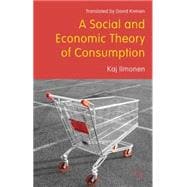
Note: Supplemental materials are not guaranteed with Rental or Used book purchases.
Purchase Benefits
What is included with this book?
| List of Figures | p. viii |
| Foreword | p. ix |
| The Sociology of Consumption: a Brief History | p. 1 |
| Classical stage of sociology: the first wave of the sociology of consumption | p. 2 |
| The second wave of the sociology of consumption | p. 3 |
| The discipline takes shape: the third stage of the sociology of consumption | p. 4 |
| Current trends in the sociology of consumption | p. 7 |
| Markets and the Neo-liberal Utopia of Omnipotent Markets | p. 10 |
| Adam Smith, the state and markets | p. 11 |
| Markets and twentieth-century neo-liberal economics | p. 14 |
| Institutional conditions for markets | p. 23 |
| Self-interested Homo economicus - an assumption to facilitate economic modelling | p. 27 |
| Neo-liberal economic theory and how it shapes the economy | p. 30 |
| Commodities and Consumption: General and Specific Features | p. 35 |
| Aspects of commodity and consumption | p. 35 |
| The decommodification of products | p. 40 |
| The multiple dimensions of commodity: methodological implications | p. 42 |
| Want, Need and Commodity | p. 45 |
| Need as a universal category | p. 45 |
| Need and activity | p. 47 |
| Interpretation, tradition and symbolic value | p. 50 |
| The historicity of desires: an empirical and conceptual analysis | p. 55 |
| Traditional and modern hedonism | p. 62 |
| Consumption and the Necessary Economic Conditions for Consumption | p. 73 |
| Income and consumption | p. 73 |
| Income, consumer-choice theory and Engel's Law | p. 74 |
| Engel's Law and income groups | p. 76 |
| On the limits of consumer-choice theory | p. 77 |
| Consumer choices and prices | p. 80 |
| The Use and Meanings of Money | p. 82 |
| Money as value and symbol | p. 83 |
| Profane and sacred money | p. 89 |
| Blessed, cursed and profane money | p. 91 |
| Use of money and ways of sacralizing it | p. 93 |
| Profane money and its uses in the household | p. 98 |
| Mechanisms of Consumption Choice and Their General Cultural Framework | p. 101 |
| Culture as a frame of reference for food choices | p. 102 |
| Gustemes of everyday food choices | p. 105 |
| Gustemes of feast choices | p. 109 |
| Mechanisms of consumption choice | p. 111 |
| Convention, tradition and consumption choice | p. 112 |
| Tradition and convention: differences and similarities | p. 114 |
| Convention, tradition, everyday and feast | p. 118 |
| Routines and consumption | p. 120 |
| Action and behaviour | p. 121 |
| Forms of behaviour and circumstances | p. 122 |
| Routines and consumption choices | p. 126 |
| Style and choice of food | p. 129 |
| Style and the problem of taste | p. 129 |
| Prestige foods and trickle down | p. 134 |
| Limits of the trickle-down mechanism | p. 137 |
| New social anchorage for food styles | p. 141 |
| Fashion and choice of food | p. 147 |
| Fashion and time | p. 147 |
| The lure of fashion: communicating contraries | p. 149 |
| Food fashions | p. 151 |
| Mechanisms of food choice and the selection event | p. 153 |
| Consumption choice - where structure and action meet | p. 158 |
| Consumption As Ideological Discourse | p. 162 |
| Ideology and everyday practices | p. 165 |
| Consumption as mediator of ideological meanings? | p. 167 |
| Commodity fetishism and consumption as a means of classification | p. 172 |
| Structural differences between men's and women's consumption | p. 176 |
| Consumption and hierarchical divisions | p. 180 |
| Consumption As Use: Our Relationship to Commodities | p. 184 |
| Consumption and our relationship to objects | p. 184 |
| Individualization and sociality | p. 186 |
| Towards a theory of use: 'work of hybridization' | p. 187 |
| Appropriation of commodities: internalization | p. 191 |
| The externalization of commodities, or how internalized commodities can assume a general meaning | p. 198 |
| Notes | p. 205 |
| References | p. 213 |
| Index | p. 229 |
| Table of Contents provided by Ingram. All Rights Reserved. |
The New copy of this book will include any supplemental materials advertised. Please check the title of the book to determine if it should include any access cards, study guides, lab manuals, CDs, etc.
The Used, Rental and eBook copies of this book are not guaranteed to include any supplemental materials. Typically, only the book itself is included. This is true even if the title states it includes any access cards, study guides, lab manuals, CDs, etc.